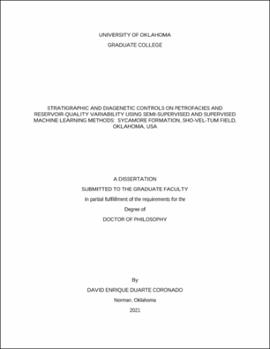| dc.description.abstract | Diagenetic processes in sedimentary rocks have intrigued geologists, but they are poorly understood. In sedimentary fine-grained rocks, there is even less information, due to the complexity and lack of interest despite the current shale boom that has resulted in increased interest in mudrocks. This study aims to explain the geological processes that affect the reservoir quality on the Sycamore siltstones and present a model that shows the spatial distribution of the thin-section-derived petrofacies for the Sycamore Formation.
This study is divided into four chapters. In Chapter 1, I will introduce my motivation, the research questions, the data available, the contributions, and the limitations of the dissertation. Additionally, in this chapter, I provide a literature review on the geology of the Mississippian rocks in southern Oklahoma, our current understanding of the diagenesis on mudrocks, and a brief explanation of the most common machine learning techniques I will use in chapters 3 and 4.
In Chapter 2, I present a diagenetic study of a mixed-carbonate siliciclastic system. This study evaluates and explains the impact of diagenesis on reservoir quality of the Sycamore Formation and identifies other intrinsic geological factors that control diagenesis. Cementation and dissolution are the main diagenetic processes that impact the reservoir quality of the massive siltstones. Additionally, differences in the sediment supply between carbonate- and siliciclastic-dominated systems drive the calcite cementation and dissolution of feldspars in the Sycamore and consequently the reservoir quality.
In Chapter 3, I propose a workflow that uses machine learning techniques to bridge the resolution gap between thin sections and well logs. To that end, we tested two semi-supervised approaches that use XRF data as input in combination with dimensionality reduction techniques to reliably classify the thin-section-based petrofacies. Both the semi-supervised approaches we use, a self-training approach and a labeled-clustering approach, achieve accuracies of more than 90% on this dataset. Therefore, implementing the proposed workflow we generate petrofacies logs for cored wells.
In Chapter 4, I present a machine learning-based workflow for assisting 3D models to reliably represent the petrofacies distribution in the Sycamore Formation. The workflow compares over 1,800 classification models and selects the best combination of well logs, algorithms, and hyperparameters to predict petrofacies in wells without cores. From 6 cored wells, the selected classification model predicted petrofacies logs on 75 wells. These predicted petrofacies logs were used to construct a 3D data-driven model. | en_US |

